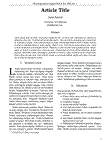Resultados de búsqueda - ((ligar OR ligas) OR (ligue OR ligules)) 1
Materias dentro de su búsqueda.
Materias dentro de su búsqueda.
-
1
Andy’s, el emprendimiento en grandes ligas: Andrea Barrera
Publicado 2024Enlace del recurso
Artículo -
2
Planificación y metodología de entrenamiento de fútbol americano de liga mayor.
Publicado 2017“…Contexto temático: Entrenamiento y planificación en el fútbol americano de liga mayor. Justificación del Tema: Proporcionar información útil y práctica para la elaboración de programas de entrenamiento en jugadores mexicanos universitarios. …”
Enlace del recurso
Tesis -
3
Planificación y metodología de entrenamiento de fútbol americano de liga mayor.
Publicado 2017“…Contexto temático: Entrenamiento y planificación en el fútbol americano de liga mayor. Justificación del Tema: Proporcionar información útil y práctica para la elaboración de programas de entrenamiento en jugadores mexicanos universitarios. …”
Enlace del recurso
Tesis -
4
-
5
-
6
-
7
-
8
-
9
-
10
-
11
-
12
-
13
-
14
-
15
-
16
-
17
-
18
A new species of Perinereis (Polychaeta, Nereididae) from Florida, USA, with a key to all Perinereis from the American continent
Publicado 2013“…The new species can be distinguished from P. brevicirrata by the absence of a notopodial prechaetal lobe, Area V with 3 cones in a triangle, and Area VII-VIII with two well-defined rows of 33 paragnaths, the basal row having longer paragnaths in relation to the distal ones. The new species resembles P. singaporiensis based on the absence of notopodial prechaetal lobe; however, the two species differ in some morphological characteristics such as tentacular cirri length, shape of dorsal notopodial ligules, and falciger blades. …”
Enlace del recurso
Artículo -
19
A new species of Perinereis (Polychaeta, Nereididae) from Florida, USA, with a key to all Perinereis from the American continent
Publicado 2013“…The new species can be distinguished from P. brevicirrata by the absence of a notopodial prechaetal lobe, Area V with 3 cones in a triangle, and Area VII-VIII with two well-defined rows of 33 paragnaths, the basal row having longer paragnaths in relation to the distal ones. The new species resembles P. singaporiensis based on the absence of notopodial prechaetal lobe; however, the two species differ in some morphological characteristics such as tentacular cirri length, shape of dorsal notopodial ligules, and falciger blades. …”
Enlace del recurso
Artículo -
20


